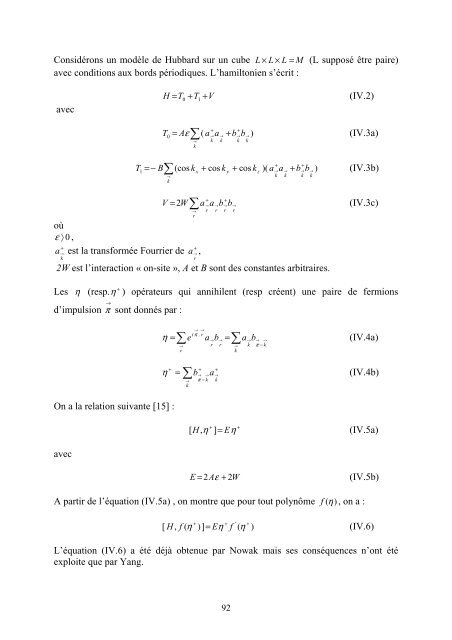Annexe IV Modèle de Hubbard standard et états cohérents - Toubkal
Annexe IV Modèle de Hubbard standard et états cohérents - Toubkal
Annexe IV Modèle de Hubbard standard et états cohérents - Toubkal
You also want an ePaper? Increase the reach of your titles
YUMPU automatically turns print PDFs into web optimized ePapers that Google loves.
Considérons un modèle <strong>de</strong> <strong>Hubbard</strong> sur un cube L × L × L = M (L supposé être paire)avec conditions aux bords périodiques. L’hamiltonien s’écrit :avecH = T0 + T1+ V(<strong>IV</strong>.2)T0= Aε ( a a + b b )(<strong>IV</strong>.3a)∑→k+→k→k+→k→kT1= − B (cos k + cos k + cos k )( a a + b b ) (<strong>IV</strong>.3b)∑→kxyz+→k→k+→k→koùε 〉 0 ,+a est la transformée Fourrier <strong>de</strong>→kV = 2 W a a b b(<strong>IV</strong>.3c)∑→r+a ,2W est l’interaction « on-site », A <strong>et</strong> B sont <strong>de</strong>s constantes arbitraires.→r+→r→r+→r→r+Les η (resp. η ) opérateurs qui annihilent (resp créent) une paire <strong>de</strong> fermionsd’impulsion → π sont donnés par :η =∑→re→ →.i π ra→rb→r=∑→ka→kb→ →−π k(<strong>IV</strong>.4a)+ +η + = b→→a→(<strong>IV</strong>.4b)∑→ π − k kkOn a la relation suivante [15] :avec[ H , η+ ] = Eη +(<strong>IV</strong>.5a)E = 2 Aε + 2W(<strong>IV</strong>.5b)A partir <strong>de</strong> l’équation (<strong>IV</strong>.5a) , on montre que pour tout polynôme f (η ) , on a :++ ' +[ H , f ( η )] = Eηf ( η )(<strong>IV</strong>.6)L’équation (<strong>IV</strong>.6) a été déjà obtenue par Nowak mais ses conséquences n’ont étéexploite que par Yang.92
















